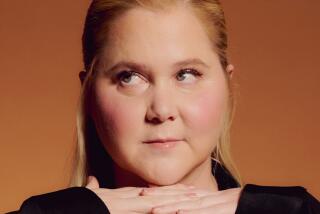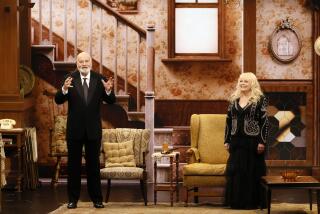âAll in the Familyâ star Jean Stapleton dies at 90
Jean Stapleton, the actress who endeared herself to viewers in the 1970s as Edith Bunker, whose sudden bursts of truth regularly cut through her husband Archieâs bluster on the groundbreaking television series âAll in the Family,â has died. She was 90.
Stapleton died Friday of natural causes at her New York City home, her family announced.
She earned three Emmy Awards starring as the wife of Carroll OâConnorâs loud-mouthed, bigoted Archie Bunker on the show, which marked the beginning of sitcoms as a forum for political -- albeit often comical -- family warfare.
As Edith, Stapleton became a role model for other women who had to deal with their own hot-headed Archies, a fact that OâConnor relished.
âBefore Edith ... women who lived with fellows like Archie were usually submissive and suffering in the face of roaring nonthink,â OâConnor later wrote of his on-camera wife. âAfter Edith, they confronted nonthink a little more sternly and stiffly and gave hint of a serious readiness to rebel, just as Edith rebelled from time to time.â
On Saturday, series creator Norman Lear said in a statement: âNo one gave more profound âHow to be a Human Beingâ lessons than Jean Stapleton. Goodbye Edith, darling.â
Eventually even Archie showed some growth on the show. He refrained from regularly calling his wife âdingbatâ and, although he remained prejudiced, he learned to curb his remarks in public.
Stapleton bowed out of the role in the 1980 season, and Edith was written out of the show as dying of a stroke. Archie was left to mourn her loss and carry on in the less popular âArchie Bunkerâs Place,â which continued until 1983. âAll in the Familyâ also spawned two popular spinoffs: âMaudeâ and âThe Jeffersons.â
The character that Stapleton created made the break-the-mold sitcom work, according to OâConnor.
âThe benign, compassionate presence she developed made my egregious churl bearable,â he wrote in his 1998 autobiography. Her âidea of Edith Bunker was not only original and perfectly suited to the American audience, but very comical and emotionally moving.â
As fans of âAll of the Familyâ observed week after week, Archieâs fruitless attempts to get his wife to âstifle yourselfâ and his many labels for âwomenâs libbers,â people of color and homosexuals only accentuated his powerlessness in a world that no longer acknowledged guys like him as kings of the hill.
He couldnât escape the evidence anywhere, least of all in his own home, where daughter Gloria, played by Sally Struthers, and her new husband, Mike, a.k.a., âMeathead,â played by Rob Reiner, lived with the Bunkers. Constant arguments erupted, often requiring the intervention of the simple but sensible Edith.
âJean was a brilliant comedienne with exquisite timing,â Reiner said Saturday in a statement. âWorking with her was one of the greatest experiences of my life.â
The program was based on a popular British series, âTill Death Do Us Part,â and brought to American viewers in 1971 by Lear, who said Archie reminded him of his own father. Until then sitcoms were mostly bland fare designed to offend no one.
Howard Rosenberg, then The Timesâ television critic, once called âAll in the Familyâ the âshocking Lenny Bruce of sitcoms,â saying that the show provided a mirror âof the worst part of ourselves, and occasionally the best part.â
In the opening to the show, Archie and Edith are at the piano in their home at 704 Hauser in New York Cityâs Queens borough. They alternate singing the lines to âThose Were the Daysâ:
Boy, the way Glenn Miller played,
Songs that made the hit parade,
Guys like us, we had it made,
Those were the days.
The song ends with Edith reaching a comic screech of warped notes that required real acting from Stapleton, who was a singer before she was an actress.
Parts of Edith were based on an aunt whom Stapleton had loved, she once said. She stole Edithâs nasal voice from herself -- she had used it in her role as Sister in âDamn Yankeesâ on Broadway.
âI had to do something to get laughs,â Stapleton told National Public Radioâs âAll Things Consideredâ in 2001.
As the show unfolded, Edithâs obvious if sometimes puzzling affection for the bombastic Archie was what lifted âAll in the Familyâ out of nastiness and allowed it to shine a light on the ways that people divide themselves from each other.
âTo unmask all those prejudices and be able to laugh at [them] was a great healer,â Stapleton said of âAll in the Familyâ more than 20 years after leaving her role as Edith.
In real life, Stapleton was quiet-spoken and dignified. She brought Edith to life with a coltish walk, blank stares and by simply speaking the truth. Unlike other sitcom wives, she did not resort to sarcasm to bring her husband down a peg.
âWhen she punctures Archieâs hot air itâs not with a wisecrack,â Stapleton said in an interview in 1971. âShe does it out of honest, native intuition.â
Hereâs some typical dialogue:
Archie (to Meathead): When your mother-in-law and me was goinâ around together, it was two years -- we never -- I mean absolutely nothinâ, not till the wedding night.
Edith: Yeah, and even then....
OâConnor later told People magazine that he wished that the show had paid more attention to the character of Edith, who was given story lines about menopause, an attempted rape, loss of faith and various acts of defiance against her husband, including getting a job against his will.
âShe was becoming a little more assertive every year,â OâConnor said. âShe was every bit as popular as Archie, and just then more important.â
After leaving âAll in the Familyâ and turning down the starring role in the long-running series âMurder, She Wrote,â which went to Angela Lansbury, Stapleton turned to other film and television projects and, in 1990, costarred with Whoopi Goldberg on the short-lived series âBagdad Cafe.â
Stapleton also returned to her first love: the stage. Among many productions, she starred in two one-character biographical plays: a musical about Julia Child and a drama about Eleanor Roosevelt.
Stapleton appeared in more than half a dozen plays by Horton Foote, including âThe Carpetbaggerâs Childrenâ at New York Cityâs Lincoln Center when she was in her 70s.
âI was very impressed with her. She has a wonderful sense of character. Her sense of coming to life on stage -- I never get tired of watching,â Foote told the Associated Press in 2002. He died in 2009.
She stayed away from roles that resembled Edith and would not watch old âFamilyâ episodes for more than a minute or two for fear that the character would creep into something else she was doing. But as the years went by, she expressed warmth for the role that had given her so much.
âEverything that it brought to me,â she said in 2008 on âThe OâReilly Factor,â âI can trace back to the fame that that gave me and recognition and acceptance and affection.â
Born Jeanne Murray on the Upper West Side of New York on Jan. 19, 1923, Stapleton was the daughter of a billboard advertising salesman and an opera singer. Her older brother Jack, who died young, inspired her to study acting, her family said.
As a teenager, she said, she was âthe last person youâd ever believe would have gone into the theater.â
âI was unattractive, overweight and painfully shy,â she told the Los Angeles Times in 1987.
Stapleton, who used her motherâs original name as her stage name, worked as a secretary while studying acting at the American Actors Company and the American Theatre Wing.
In 1949, she got a break when she was cast in the national touring company of âHarvey.â
Many characters later in summer stock, regional and off-Broadway plays, Stapleton starred as a wisecracking waitress in a 1953 Broadway production of âIn the Summer House.â
She went on to a feature role as Sister in âDamn Yankees,â singing the hit tune âYouâve Gotta Have Heart,â and reprising the part in the 1958 film.
She also appeared on Broadway in the late 1950s in âBells Are Ringing,â and in the 1960 film, as Sue, the proprietor of Susanswerphone Service. And in 1964 she originated the role of Mrs. Strakosh in âFunny Girl,â which made a Broadway star of Barbra Streisand.
Stapleton also appeared frequently at the Totem Pole Playhouse in Fayetteville, Pa., which was operated by William H. Putch, whom she married in 1957.
âI married a summer theater,â Stapleton once said of Putch, who died of a heart attack at 59 in 1983 while they were touring with a play he directed.
She went onstage in Syracuse, N.Y., that night and continued with the tour.
âI realized it was a refuge to have that play, rather than to sit and wallow,â Stapleton told People magazine in 1984. âAnd it was his show.â
She never remarried.
Her âAll in the Familyâ husband, OâConnor, died in 2001.
Stapleton, who had a home in Los Angeles for many years, returned to New York City to live in 2002.
She is survived by her daughter, Pamela Putch, a television producer, and her son, John Putch, a film and television director.
Claudia Luther is a former Los Angeles Times staff writer.
Times staff writer Valerie J. Nelson contributed to this report.
More to Read
Sign up for Essential California
The most important California stories and recommendations in your inbox every morning.
You may occasionally receive promotional content from the Los Angeles Times.










